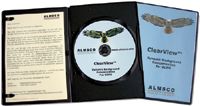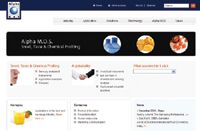Digital Update
ALMSCO International announced it has made several significant enhancements to its ClearView chromatography/MS data reprocessing software, which is distributed exclusively by Markes.
Chromatography/MS software
ALMSCO International announced it has made several significant enhancements to its ClearView chromatography/MS data reprocessing software, which is distributed exclusively by Markes. ClearView is now available on a 12-month licence in addition to the time-unlimited version. The software is now reported to be compatible with all major GC–MS vendors' data acquisition and analysis software and some LC–MS formats. ClearView uses a dynamic background compensation (DBC) algorithm to distinguish between chromatographic peaks and chromatographic background/baseline anomalies in stored data files; the original data files are left intact and unaffected. According to the companies it aids the automatic identification of trace components by eliminating noise and background interference and improves the repeatability of integration/quantification.

Replacing paper-based protocols
Waters has announced an expansion of its liquid chromatography system qualification tool for its Empower Chromatography Software. The Empower Systems Qualification Tool (SystemsQT), which has been available only for Waters instruments, now supports Agilent 1100 and 1200 series HPLC Systems in laboratories that use Waters Empower software for enterprise chromatography data management. According to the company the software tool reduces the amount of time to qualify Agilent HPLCs by 40% when compared with traditional, paper-based protocols. This tool is designed to give laboratories a means to replace currently paper-based and labour-intensive qualification/re-qualification protocols with a new standard for automated and 21 CFR Part 11 compliant qualification. The company claims that for regulated laboratories with large numbers of liquid chromatographs, the savings could be dramatic because streamlining the qualification process reduces downtime and increases instrument utilization rates.
Preparative LC software
ClarityChrom Prep is Knauer's preparative HPLC software solution, which features a graphical editor for intuitive fraction-collection programming, a graphical presentation of the fraction collector rack and linking between fraction vials and the corresponding chromatogram. According to the company it supports control of a feed pump and control for fraction collectors from B?chi, ISCO and Knauer. Peak recognition can be triggered by either "level", "slope", or "level and/or slope" separately for peak begin and peak end. Solvent recycling can be carried out within the peak recognition interval. In addition, the fraction collector can be controlled manually and switched to "collect", "waste" or "solvent recycling" position during a run. For timed events the user can define the respective vial positions. Besides this, the software is a full featured analytical HPLC software solution including Autosampler control.

Alpha MOS new website
Alpha MOS has introduced a new website including numerous features and sources of information, such as user testimonials in various industrial areas, a section dedicated to human and instrumental sensory analysis with quality and R&D application examples and hot topics on new products and applications. The information is searchable by industry, application and solution, and products and services can be viewed on-line and sorted by application. The website is available in English, French, Chinese.


Altering Capillary Gas Chromatography Systems Using Silicon Pneumatic Microvalves
May 5th 2025Many multi-column gas chromatography systems use two-position multi-port switching valves, which can suffer from delays in valve switching. Shimadzu researchers aimed to create a new sampling and switching module for these systems.
Studying Cyclodextrins with UHPLC-MS/MS
May 5th 2025Saba Aslani from the University of Texas at Arlington spoke to LCGC International about a collaborative project with Northwestern University, the University of Hong Kong, and BioTools, Inc., investigating mirror-image cyclodextrins using ultra-high performance liquid chromatography–tandem mass spectrometry (UHPLC–MS/MS) and vibrational circular dichroism (VCD).

.png&w=3840&q=75)

.png&w=3840&q=75)



.png&w=3840&q=75)



.png&w=3840&q=75)










